NEW
Simulating a tree
by Victor Reijs
is licensed under CC BY-NC-SA 4.0
This web page will look at how to simulate a
leafed and leafless tree (as solid objects or as a porous object
with a Darcy-Forchheimer
medium or a Perforated plate
medium. The outcome can be
seen in this summary.
Several parameters are mentioned when talking about porosity: Cd, CdSIM, Cm, Cw (=Cd/2), LAI (Leaf Area Index), LAD (=LAI/H; Leaf Area Density), f (=2*LAI/H*Cd), aerodynamic porosity: AP, optical porosity: OP [Gonsales, 2018], free area ratio (=OP), crown transparency (=porosity), and ruwheidsdichtheid (aerodynamic porosity).
A tree is a porous medium, so the naming for flow zones seen due
to a porous medium are [Judd, 1996, Figure 1]:
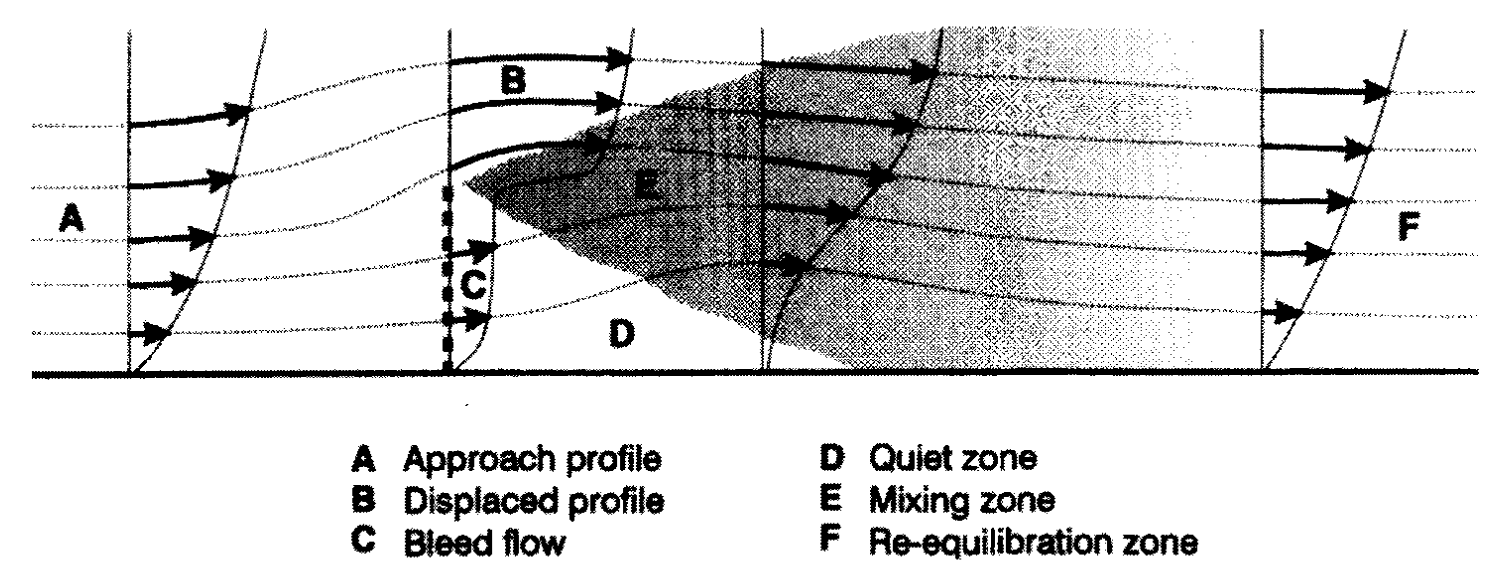
There is a specific effect due to the trunk of a tree: bottom gap
(Mayaud, 2016]. The wind speed after the trunk will be higher than
the wind speed before the tree, due to the compression caused by
the crown (see here for an example).
On this web page the Drag force and Pressure-difference
convention are built around:
In Hagen
(1971, formula [2]): Dh = F = ρ/2*u2*H*Cdhag
<H is the height of the windbreak>
With dΔp/dx =Dh/A
→
assume A=H2*π/4 → dΔp/dx = ρ/2*u2*[Cdhag/(H*π/4)]
Cd = Cdhag/(H*π/4)
Hagen
(1971) gives an idea of Cdhag
for an slatted fence (Hwindbreak
= 2.44m) with 40% porosity (and u's between 5.5 and 11m/sec):
Cdhag = 1.17
Cd = 0.61
In Roubos
(2014, formula under Fig. 127) : Qw;rep
= F = ρ*u2*A*Cwrou
<A is the area of the tree crown>
With dΔp/dx
=Qw;rep/A → dΔp/dx =
ρ/2*u2*[2*Cwrou]
Cd = 2*Cwrou
Roubos
(2014) gives an idea of Cwrou
for an oak (Htree = 15m): Cwrou= 0.25
Cd = 0.5
In Koizuma (2010, forumula1) : Pw = F = ρ/2*u2*A*Cdkoi
<A is the area of the tree crown>
With dΔp/dx
=Pw/A → dΔp/dx = ρ/2*u2*[Cdkoi]
Cd
= Cdkoi
Koizuma
(2010) gives an idea of Cdkoi
for poplar (Htree = 12.5m):
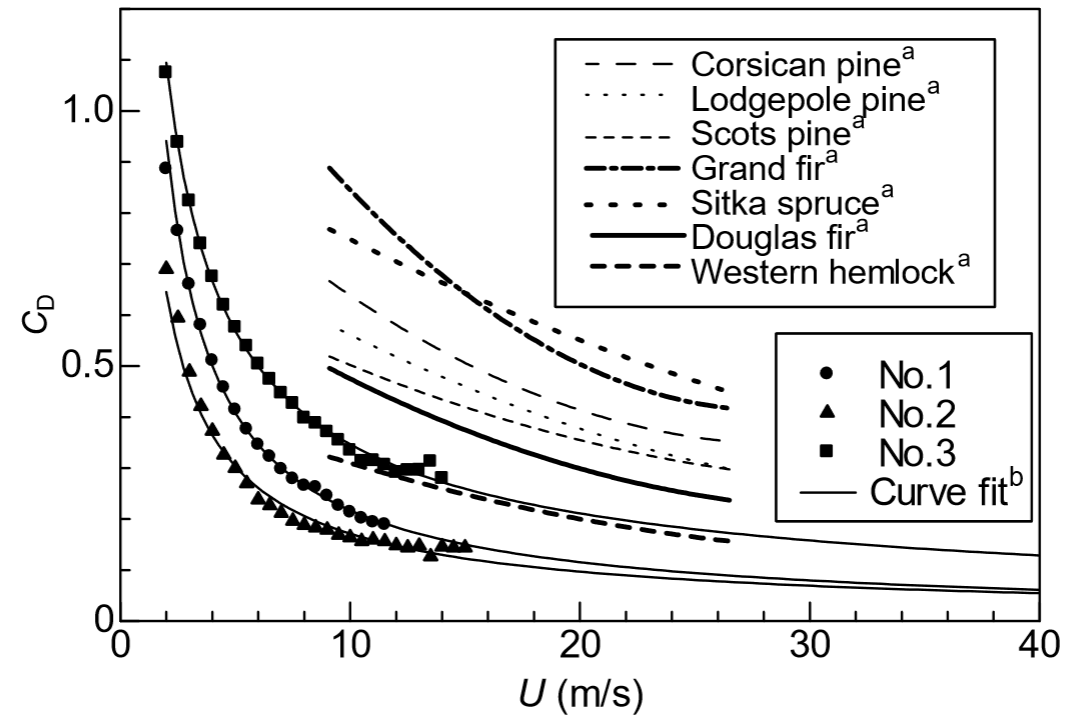
The above values of Cd (green is what the given values
for leafed deciduous trees are in the reference) are put in below
table:
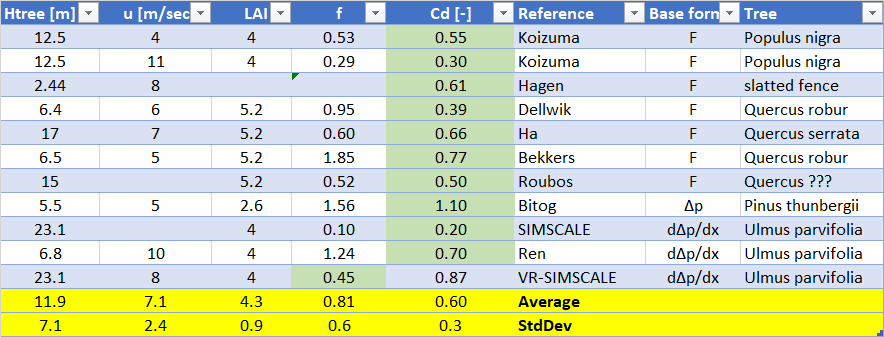
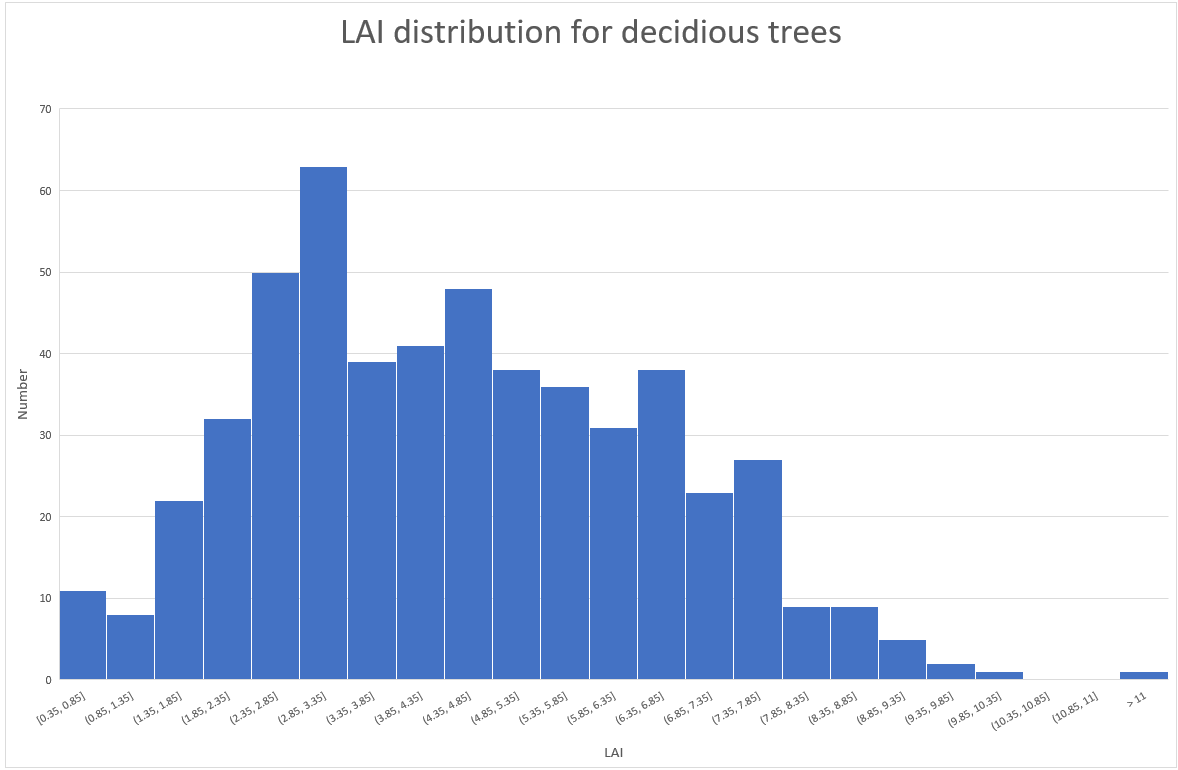
The Cd is
depending on:

In SimScale (2022
and 2023):
S
= -ρ/2*|u|*u*f = -ρ/2*|u|*u*[2*LAD*Cdsim]
fsim
= 2*LAD*Cdsim
= 2*LAI/Hz*Cdsim (see also in this SimScale spreadsheet
for this formula; tab Tree Model)
<Hz
is height of crown [Hcrowneff ~ (2/3)*(5/6)*Htree
~ 0.55*Htree] and Hx =Hy is
diameter of crown; LAI is Leaf Area Index; Cdsim
= 0.2>
Remark: Cd
is depending on the velocity,
SimScale's has
included in their feature
wishlist the fsim
dependancy?
The following points are important to
understand fsim (pers. comm. SimScale, 2025):
Periode voor bebladerd en kale bomen verkregen via Temple (pers.
comm. 2024)
It is assumed that for the Darcy-Forchheimer metholdogy only the
Forchheimer coefficient is important when dealing with trees, see
also here (section Tree Model).

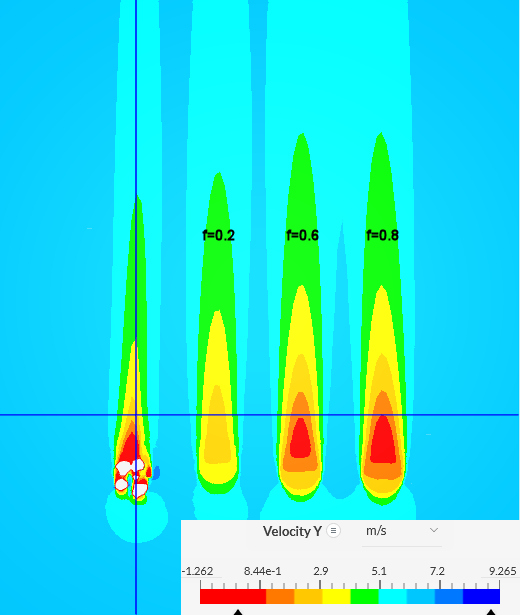
Here is an analysis done for f =
0.1 (leafless tree), 0.35 (like close to SimScale), 0.45 and 0.55 (so only
stacked-cylinder objects):

Proposed to do a third iteration with; f = 0.09 (leafless tree), 0.375, 0.4 and 0.425
Here is an analysis done for f =
0.9, 0.375, 0.4 and 0.425:
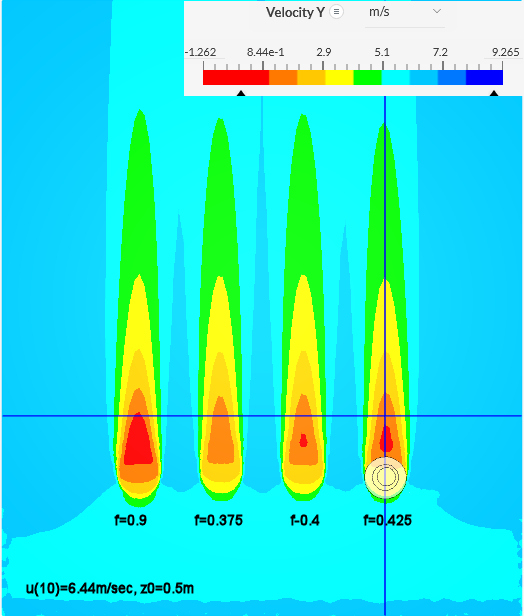
So f=0.425 looks to be ok-ish for a leafed tree (@ u(10)=6.44msec
and z0=0.5m).
Here is an analysis done for f =
0.09 (leafless tree), 0.4, 0.425 and 0.45:
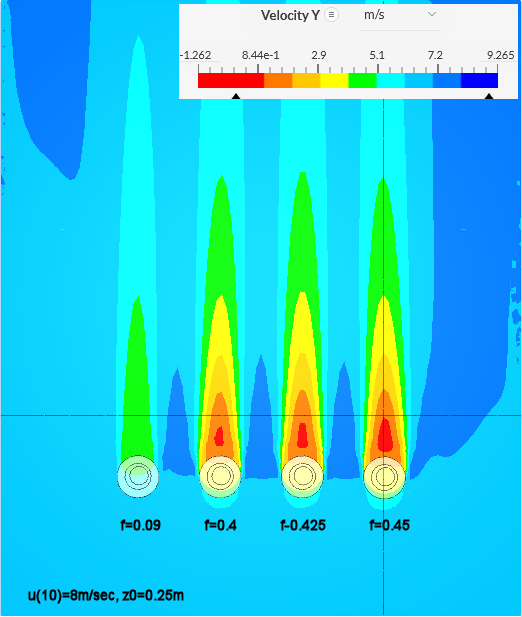
So the leafed tree with f=0.45 looks best @ u(10)=7.17m/sec (u(Htree)=8m/sec)
and
z0=0.25m.
The CFD behavior (Htree=15.5m,
Hcrown=11.5m,
z0=0.25m, u(Htree)=8m/sec)
of the stacked-cylinder object
with
Darcy-Forchheimer
medium or the
blobbed object without
Darcy-Forchheimer
medium, provides a
good match with the velocity
distribution of the real leafed
tree (Ren,
2023, Fig. 16a2):

In above graph the bottom gap due to the
tree truk is seen: the light-blue patch [due bottom gap] below the
red patch [mixing zone].
Using fVR = 2*LAI/Hcrown*CdSIMVR,
would make a CdSIMVR of
0.65 (= fVR*Hcrown/2/LAI
= 0.45*11.5/2/4).
Derived reference
parameters (from above comparison)
are:
fref ~ 0.45 [1/m]
at Hreftree=15.5m,
Hrefcrown=11.5m,
LAIref=4
and uref(Hreftree)=8m/sec
For other H, LAI
and u:
fother
= fref * Hrefcrown
/ LAIref * LAIother / Hothercrown
= 1.29
* ucomp * LAIother / Hothercrown
with:
ucomp=( uother(Hothertree) / uref(Hreftree)
)0.3 (using emperical
optimisation) -> 0.52 * uother(Hothertree)0.31
Be sure to check if porosity is optical or aerodynamic. As
optical is easier to measure (take a photo), this has been
utilised on this page. The conversion can be seen here [Gonsales, 2018, Figure 9]:
AP = OP0.65
Below
formula need to be checked (as the AP formule was wrongly
transcribed and also the exponent has been changed, from
0.65 (Gonsales, 2018, Figure 9) or 0.36 (Grant&Nickling,
1998; Ren, 2023]
An optical porosity
=
-0.267*LN(f)+0.1267 formula was derived by matching the results
of Darcy Forchheimer coefficent (f) and Perforated
plate (Free area ratio=optical p[orosity]) simulations of
a stacked-cylinder
object in SimScale (honeypot):
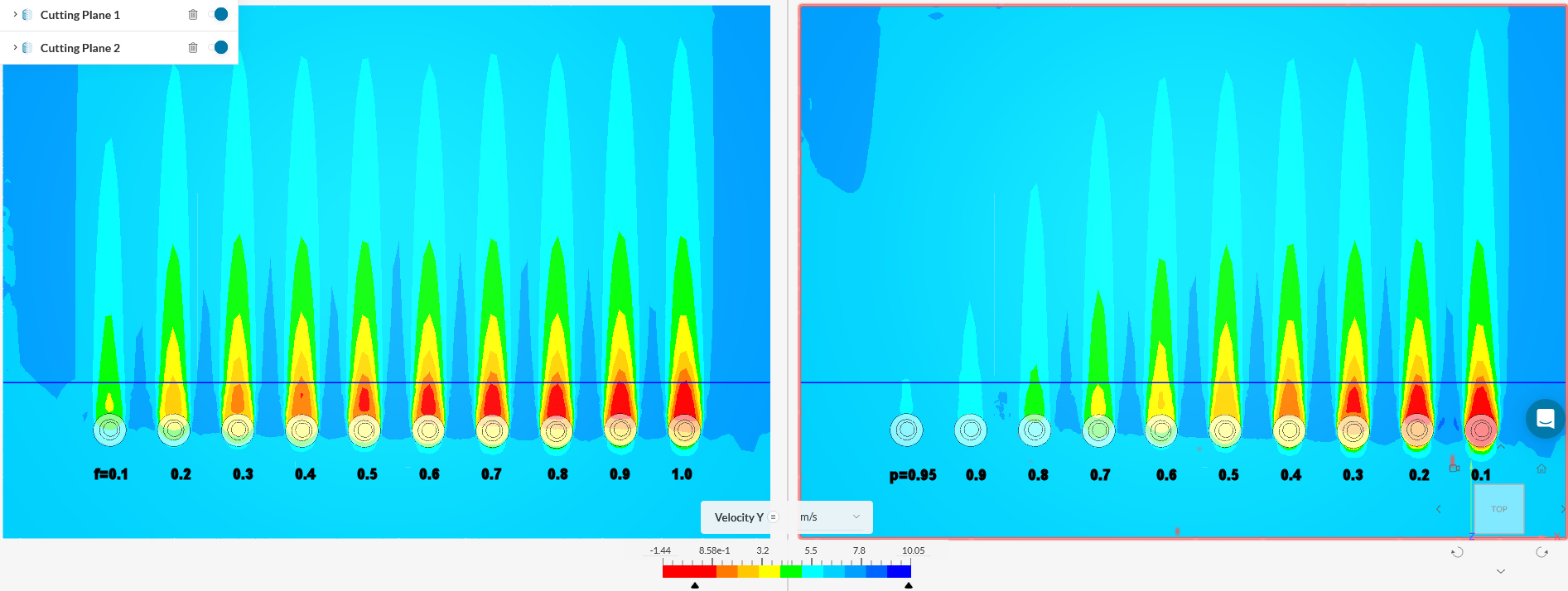
The optical
porosity [Gonsales, 2018, Figure 9] formula
=
-0.267*LN(f)-0.0108 is also derived
from above picture:

Reijs (2024, f - blue), Hagen
(1971, Cd - grey), Stichlmair (2010, Cd - formula (11)
and (13); thick plates are assumed to have relatively small
holes: yellow), SimScale (f - green) are
different, but perhaps not that far off.
Hagen and Stichlmair don't work
with trees, but fences or plates.